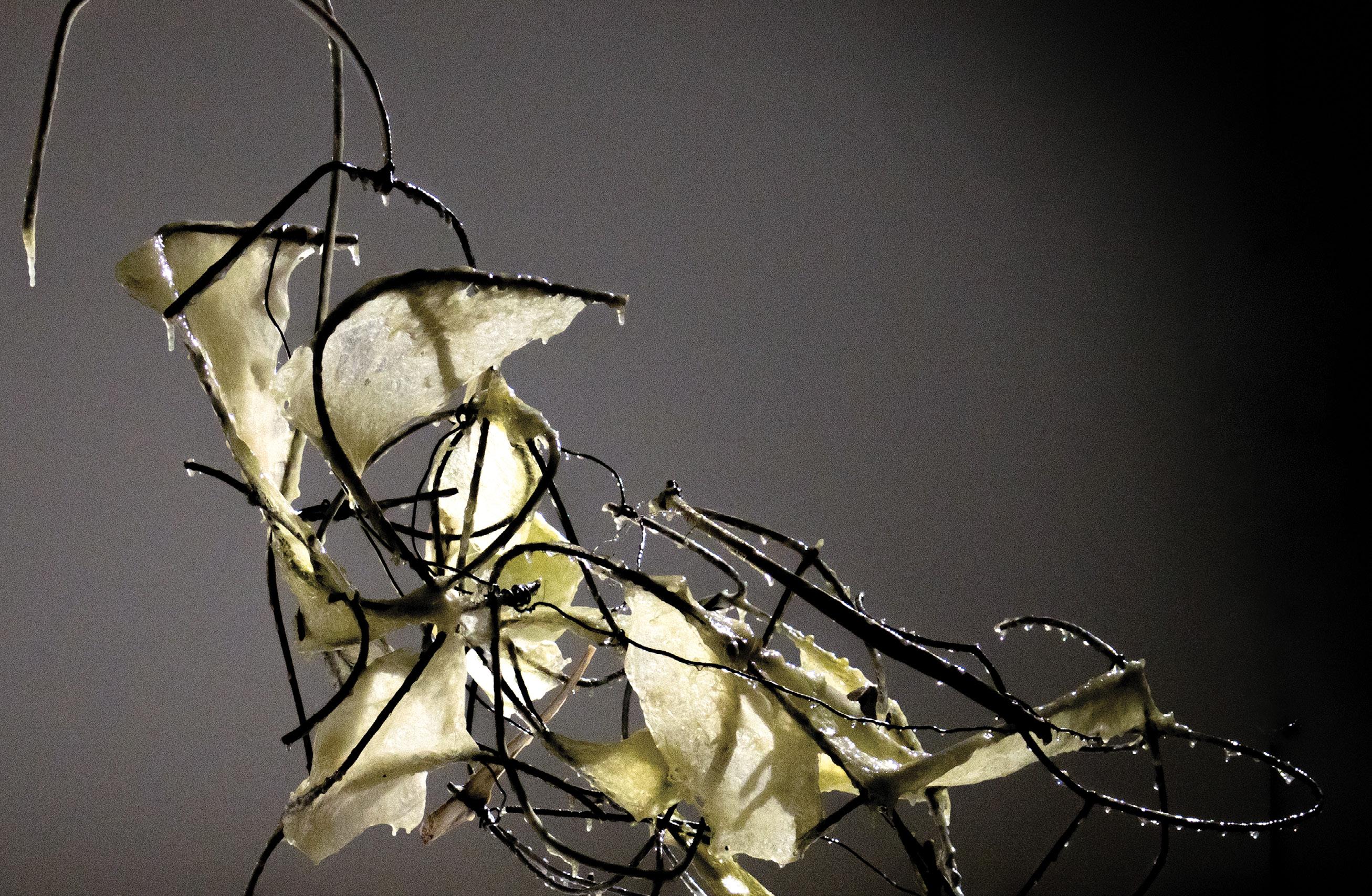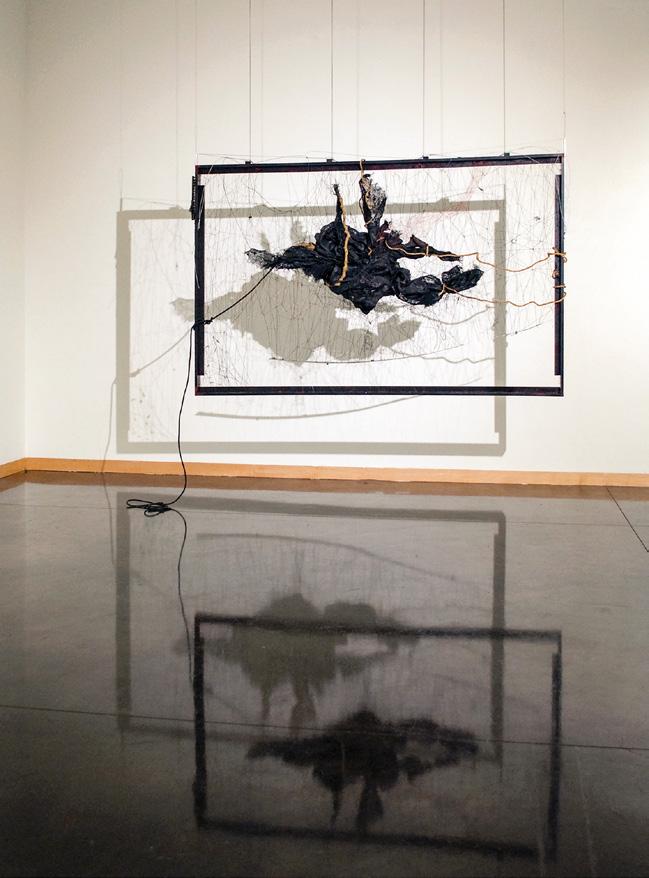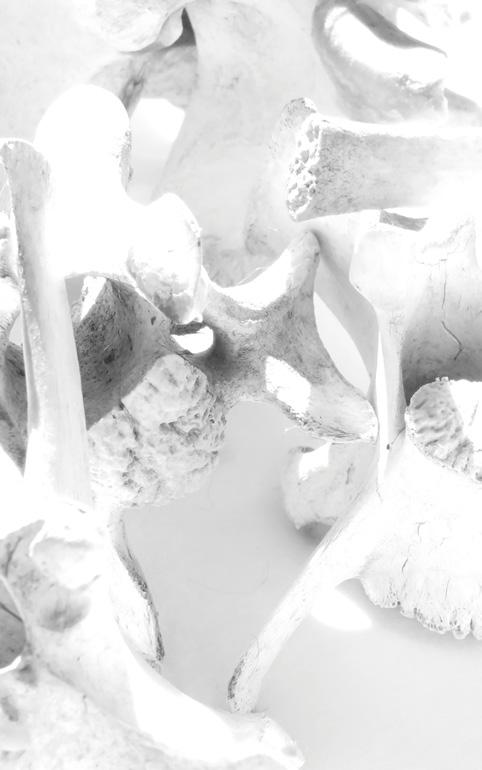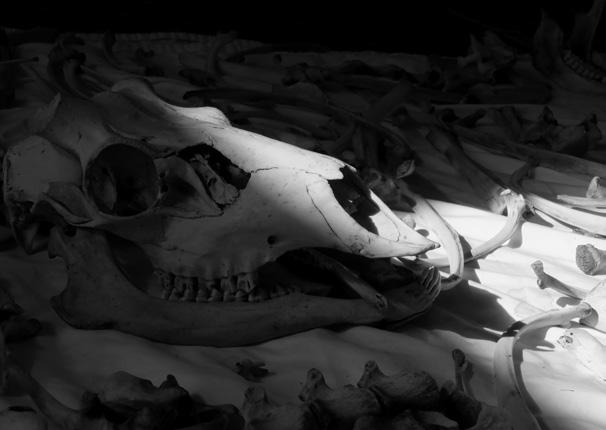
14 minute read
Kathryn Hart: The Psychic Heritage of Powerful Women
KATHRYN HART THE PSYCHIC HERITAGE OF POWERFUL WOMEN
"REVISIONISM" Issue, The September Issues Magazine, No. 3
Advertisement

New Dawn 1, wire, fiberglass, resin, bone and mixed media
Personal Structures - Identities, European Cultural Centre, 58th Venice Biennale
KATHRYN HART is an abstract artist who works primarily in sculpture. Here in a deeply personal letter on her inspirations and connections to Revisionism, she reflects on the influence of the early feminists, the tenacity of the human spirit, the depths of grief, and the power of work that strives towards truth.
My artworks are guided by deep feeling and primal emotions -- life, death, and hope. They are underpinned in Humanism and Feminism, exalting the tenacity of the human spirit. I take an unflinching view of the viscera experienced which makes life possible. I believe that deep feelings of loss, pain, and grief are expressions of love and that death is evidence of living. I honor the process of life and all of its emotional turmoil.
My work strives towards truth, not prettiness. I aim to reveal the underbelly, not veil it, as a way of knowing the lasting core which shines beyond the white noise of society, family, and personal experience.

Invisible Fissure, 66x98x8 inches
My focus on feminism and advocacy for those who have been pushed to the margins of society has brought me to creative endeavors that shed light on key energies and individuals whose histories have been overlooked. My current series explores early feminist writings and the psychic heritage these iconoclastic women passed down across disparate time periods, cultures, geographies, and how it links to my own pioneering lineage.
All of my work embraces the tension between renewal and entropy, growth and decay, life and death. I highlight the commonplace in life, that which is the necessary pulse of life.
I am interested in female agency, power, and self-determination— role shifting and core identity. Women continue to morph, change, remake, revise, renew, and transform— often having to capitulate to constraints, expectations, boundaries (externally and self-imposed), and thrones of power.

CODA, installation detail
When women are vilified with slander and outrageous criticisms, it usually means they have power and influence, which is unsettling and threatening to men. Slander turns to myth, which turns into legend, which becomes recorded as history written by men.
Before the early feminist writings of the 1300- 1500s, it was generally accepted that women were less intelligent than men, with less capacity for learning. Typically, throughout history, once a woman married, she became the property of her husband. She owned nothing, had nothing, and was nothing more than the caretaker of the home, hearth, and children.
The Counter-Reformation and the Church played a major role in defining the role and status of women in 16th century Italy. Viewed as emblems of Catholic morality, women were relegated to the role of domestic servant. Little to no value was placed upon the pursuit of knowledge for aesthetic and intellectual purposes.
Literate women could even be suspected of witchcraft since popular opinion endowed the written word with “magic powers.” Women were strictly forbidden to attend universities. Married women were forced to suppress their individual needs and desires to their husbands. It is not surprising that men exclusively dictated the societal expectations of women: chastity, silence, modesty, reticence, sobriety, obedience. Basically, married women were supposed to shut up, do what they were told, have no sex drive, and remain ignorant.
I cringe when I imagine the frustrations of so many talented, intelligent women being enslaved to a home, hearth, and children. For some, I’m guessing that death during childbirth was a relief from the drudgery and indignities.

Thin Skinned, 57x35x17 inches
During La Serenissima—“the Serene Republic”— of Venice, which existed from the 7th to the 18th century, there was freedom of expression for both men and women. This brought forth many writings from and about women. I am inspired and awed by the writings of iconoclastic Renaissance women criticisms of the social norms. Their writings about female agency, power, and self-determination have left a psychic legacy that continues to be relevant.
Fonte writes in The Merits of Women, Wherein Is Revealed their Nobility and the Superiority to Men, “Do you really believe…that everything historians tell us about men– or about women– is actually true? You ought to consider the fact that these histories have been written by men who never tell the truth except by accident…” Fonte was a prolific writer and poet, but once she wed, her writings were less frequent, which further attests to the social norm of the day that women sacrificed their talents and desires to their husbands.
I am not surprised that women who had a viable alternative to marriage during this period would take it. In the Venetian Republic, courtesans eschewed the shackles of marriage and were granted more physical freedoms and access to the poetic discussions, concerts, and debates that took place within informal salons for intellectual cultivation. Franco, among several other leading women, used the salon as a platform to let her voice be heard.
Franco is one of the most famous cortigiana onesta (honored courtesan as opposed to common prostitute) of the Italian Renaissance. She recast virtue as intellectual integrity, not chastity, and offered wit and refinement in return for sponsorship and a life in public. She was highly regarded by fellow poets for her creativity and literary talent, for being an advocate for women, and by some male royalty for her cultural and social refinements. Being civic-minded, Veronica petitioned Venice to start a home for destitute women. She set in motion the energy that women should be valued for their intellect and talent, not their ability to breed and take care of a house. She wrote openly about sex and penned erotic poems. Despite all her sophistication and contributions to poetry and literature, Venetians focused on her reputation as a “courtesan” and the sexual aura surrounding her. Scandal was more interesting than her cultural achievements. She was put on trial by the Inquisition for being a witch because of her literary prowess. Although the charges were dropped, she died destitute.
For my upcoming exhibition in 2020 with the Cultural Department of Gandia, Spain, I also heavily researched the Borgia family (Pope Alexander VI, Rodrigo Borgia) and was stunned to discover a plethora of text about the infamy of Lucrezia Borgia, the pope’s daughter. She was accused of any and all of the following: sleeping with both her father and brother, being a femme fatale, a manipulator, and a murderer.
As is typical, histories are written my men who record the “facts” loosely. None of these accusations of Lucrezia have proven to be true. In fact, Lucrezia was honored as governor of Spoleto instead of a male relative, and she helped her husband Alfonso D’Este govern the duchy of Ferrara (in the Veneto district of Italy). Lucrezia was given administrative management of the pope’s correspondence, and the “out of wedlock” child she was accused of bearing has been surmised as being a hidden child of her father or a brother.
While she was used as a political pawn by her family, as most women were during that time, Lucrezia managed to push against her chains, expanding her influence while operating within the chokehold her family had upon her. Unfortunately, she died in childbirth around 1520, but she left an admirable legacy and example of self-determination.
But long before Lucrezia Borgia, Veronica Franco, and Moderata Fonte, there are records of women protesting in ancient Rome for changes in marriage reform, sumptuary laws, and even weighing in on opinions about war. They incited political change, and their voices have had lasting power.
Women morph, renew, remake, and capitulate to retain their core identities within the constraints placed upon them, while at the same time pushing outward against these ropes.
I come from a line of strong and adventurous women and pioneering stock. All of my maternal great-great grandparents immigrated from Sweden with hopes for better opportunities in America. My great-grandmother Maggie was made of stern stuff. Badass. Fatherless from age eight due to a threshing machine accident, it was said her posture defied any pity, and the sunburned hands with which she gripped the reins of her horse allayed any doubts about her capabilities.

Dinner With Lazarus, detail
In 1894, she drove a wagon across the Oregon Trail carrying her five children, including my three-yearold grandmother. She faced drought, inclement weather, predators, snakes, rutted washouts, the Tetons, Indian Territory, and others trying to thwart her path. She traveled the final 400 miles alone, and I’m told she stayed awake each night with her shotgun on her lap.
My mother, a Depression baby, was a feminist before the word was widespread. She became a microbiologist, earning her Master’s degree postdivorce at age 43 and worked in the bone marrow transplant lab of a major hospital. As a 16-year-old college freshman (she skipped two grades in high school), she was one of three women in a biology lab full of men, all of whom had just returned from WWII. She wanted to be a doctor, but that was not possible at the time. She met my father in that biology lab, and they married when she was just 19.
Four kids within a five-year period followed, and her dreams were superseded by children, diapers, the house, and working to put my dad through medical school. She was terribly bored as a wife, housekeeper, and mother and continued her education with numerous undergraduate science classes. She was not warm or nurturing, but she was interesting, had integrity and tenacity, and insisted upon her worth. My mother broke molds, and that attitude rubbed off on me.

Vertebrae and Ribs 2A1, pigment print on film mounted on aluminum plate, 54x36 inches
I am dismayed that some of the same societally imposed constraints against women, which were emphasized by the women’s rights movement of the 1960s, still exist. The nastiness of the 2016 elections and post-election period honed that men are not held accountable, and it further proved that horrendous attitudes and behaviors towards women remain acceptable to society at large. So much so that the epitome of a misogynist was elected president instead of a powerful, well-qualified woman (although she was not without fault). I was disgusted, disheartened, and disillusioned with the values of our country.
As a woman in her 50s, who was raised in Texas, I have been exposed and subjected to harassment, chauvinism, and the glass ceiling in the workplace. My upbringing was overwhelmingly colored by the idea that a woman’s worth was tied to some subjective ideal of attractiveness. My father was a renowned plastic surgeon, and although I respected and admired his skill, the prevalent attitude in my household was that if I “didn’t turn out well” then he could “fix it.” WHAT THE FUCK? What does THAT even mean? Clearly, it was a requirement that I conform to his standard of beauty. The ingrained message was that my value as a person was inextricably linked to my physical appearance. Too bad I was a chubby adolescent with frizzy hair and braces.
At an early age, I knew my coinage suffered. Kindness, curiosity, talent, intelligence, generosity, perseverance, and so many other traits took a back seat to the agency of that first glance. I was well into adulthood before my full anger and resentment about these attitudes reared up, never to be silenced.
Throughout the struggles in my own life—disease, deaths of loved ones, traumas and violence—I’ve realized that at the core of living is a multitude of emotions spanning both ends of the spectrum. I wouldn’t know such great joy without having experienced pain and devastating loss, sorrow and contentment, grief and happiness, fulfillment and despair. Growth is spawned from adversity.
We experience a thousand emotions at once and piece-parting them out to make sense of it all is impossible. The written language is linear, paragraph by paragraph, sentence by sentence, letter by letter. But life hits all at once. I don’t have the luxury of a linear experience, nor would I want one. I make art to express this miasma of emotions—they circle back on each other to be reviewed and experienced over and over again. It is a cyclic process of revise, renew, retain, explore. I want my works to have a multilayered meaning and titles that offers multiple interpretations. They include the dichotomies of Object/Shadow, Shape/Texture, Touch/Don’t Touch, Sensual/Grotesque, Embryonic/Decay.
I am interested in the making of things– the physical process guided by a set of binary primal emotions or deep feelings with HOPE at the core. The ability to have hope is what drives one forward through difficulties. While I cannot say for certain about animals, I suspect that long-term hope and vision are uniquely human traits.

Skull and Bone 6, pigment print on film mounted on aluminum plate, 18x27 inches
I am continually amazed at the tenacity of the human spirit and what appears to be an ever bubbling well of hope. Why is this my focus? Hope has been a constant, necessary friend for most of my adult life.
When I was 27, a strange, insidious illness invaded my body. It took several years to diagnose the rare autoimmune disease that had taken hold. My body was eating itself from the inside out. There was little treatment available, no cure, and I wasn’t supposed to live more than a few years. The only other few with my condition gradually moved to an iron lung and then died shortly after. Despite my hair falling out, my muscles atrophying, all my joints painfully swelling, and my skin eroding spontaneously, I didn’t accept I was as sick as the doctors said. I’ve heard that both denial and hope are common traits for entrepreneurs. I believe these same traits were true for me at the time…and are true for most artists. Thirty years later, I’m still here. I am the unicorn who is the subject of several white papers in medical journals.
At the height of the onset of my disease, I had a stalker who successfully broke into my home. I was held hostage, tortured, raped, and left for dead. I won’t dwell on all the ugliness here. This person preyed upon the weak and set in motion in me an adamant advocacy for those who cannot speak or act for themselves.
I hate bullies, manipulators, liars, and violence. Of course, I wish this violent attack and all its lingering effects had never happened, and as anyone who has experienced something like this knows, you don’t ever get over it. It forever leaves an indelible imprint. At best, it fades, but hope drove me forward. Despite staying up all night for a year with a baseball bat in my hand staring at the door, HOPE was my backbone and friend. I was overwhelmingly humiliated, embarrassed, and stripped of dignity. I was terrified of everything. I am still afraid of the dark.
Every two years, I write or talk to the parole board to ensure this monster stays locked up. It is my duty and advocacy for other women. I’ve never publicly discussed this experience…been so openly raw, exposed, and vulnerable. But this issue is about Revisionism, and in full authenticity, I must disclose those events which have had significant impact on my path, identity, and view of the world. I had to revise my ideas about myself and try hard to retain the unique kernel that is me, despite ugly happenings. All of these experiences guide and impact my art making.
My struggle with my autoimmune disease and the violence brought a focus to my mortality in my late 20s: issues of life and death, disappointments, and dreams dashed expounded. I realized deep feelings and emotions are the crux of living. As a woman, I understood how my agency changed when my attractiveness waned with the disease and when my sense of self was shattered by the assault. Disillusionment and resentment have led to an ingrained feminism and reliance on my own power and self-determination.

Derailed, Installation, Kotlownia Galerie, Krakow
87x104x38 inches
Everything which has ever happened to me has brought me to my current place. I like who I am and where I am, so I must be grateful for every moment. It all contributed to my identity. I cannot pick and choose the moments I prefer to keep. It is all part of the whole.
My art making is also influenced by my scientist parents and my own career in organ transplantation research. These fostered a fascination with the unseen intricacies beneath the skin and the relationship of each integral part to the physical, emotional, and psychic whole.
The shapes I create are figurative from the inside-out. Precise surgical knots become synapses within chaotic webs of connections. Built up in three dimensions with line, space, gesture, and shadow, my sculptures and wall reliefs respond to their environments and to viewers moving around them, altering the surrounding light and air. They pulse and breathe with energy and do not flinch from the viscera that makes life possible. Pieces can morph and weather from the effects of time. The diseases and deaths of my own loved ones have taught me to honor the processes of life and to honor the privilege of bearing witness.
As a plastic surgeon’s daughter, slicing and suturing come naturally to me after frequently observing surgeries. My work strives towards truth rather than prettiness. Truth is Substance and Beauty. Most of my work is predominantly monochromatic, as I do not care to manipulate the viewer’s experience with color. My sculptural materials are twisted, stretched, pressured, tied, and trapped; they push and bulge and occasionally burst out, representing the reinventions, renewals, revisions, struggles, strategies, and capitulations of women operating in a world designed by men. I search for the essence of identity that is heard above the static of social and familial roles. I value most the uniqueness of the individual and our shared humanity. It is not beautiful; it is life.
For my solo presentation, Personal Structures - Identities, with the European Cultural Centre during the 58th Venice Biennale, I showcased NEW DAWN, a site-specific exhibition of sculpture and photography created for the unique space of the Palazzo Mora’s 3rd floor. NEW DAWN reflects on the simultaneous organic processes of regeneration and degradation.
Each sculpture of wire, fiberglass, found bone, resin, and wax sways towards either becoming or eroding, expanding or contracting, developing, remaking or becoming anew individually or collectively, prompted by internal impulse and not external constraint. Sculpture boundaries are like membranes, permeable to light, air, space, energy, emotion, and idea. The wire and fiberglass sculptures concurrently glisten with an embryonic presence and molt their skins. Cast shadows of line and shape creep along curved surfaces.
These sculptures are abstract embodiments of the energies, transformations, renewals, and capitulations that women endure. Women are pliable and elastic, able to change in order to grow and be fulfilled within the arena we must operate.
In the abstract photographs in the exhibition, found deer bones reveal transformation after long-term exposure to the natural elements. They become translucent to light and full of graceful energy. Symbols of decay alter into pictures of rebirth. Both the sculptures and photography are reflections of the natural cycle and unique moments. Microcosm mirrors macrocosm.
Included in this exhibition are inspirations from trailblazing women Lucrezia Borgia, Veronica Franco, and Moderata Fonte, among others. I explore and highlight the psychic heritage these influential women passed down and the agency they exerted over politics, literature, poetry, and freedom for women.
My feminism has been influenced by my Dallas roots, my plastic surgeon father, my illness, my assault, my husband’s cancer, and my advocacy for others and awareness of those whose voices are not sufficiently loud enough to be heard. I repel the arbitrary constraints placed upon my opportunities because I am female. As women, we push against these boundaries yet manage to operate within them to fulfill our dreams and desires.

Kathryn Hart
Photo credit: Dani Dodge

